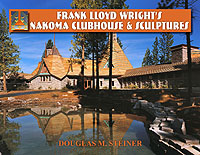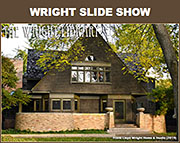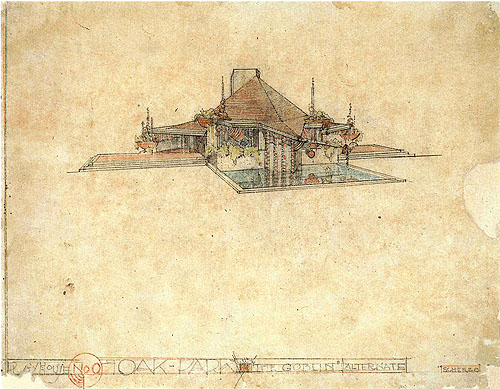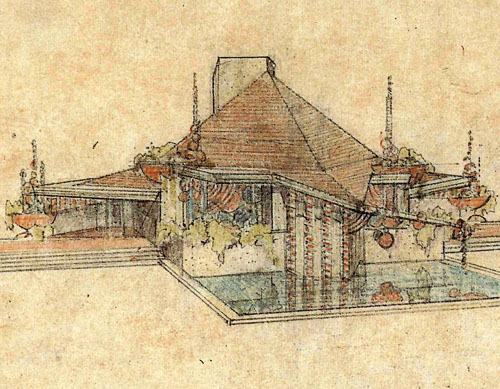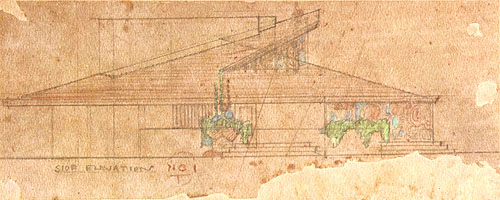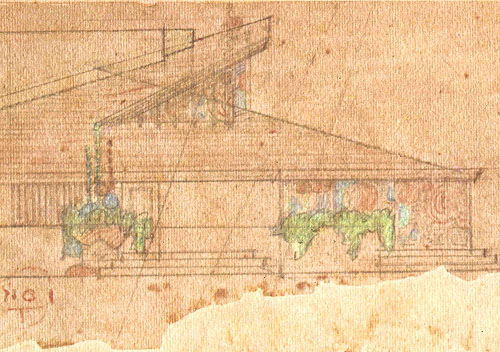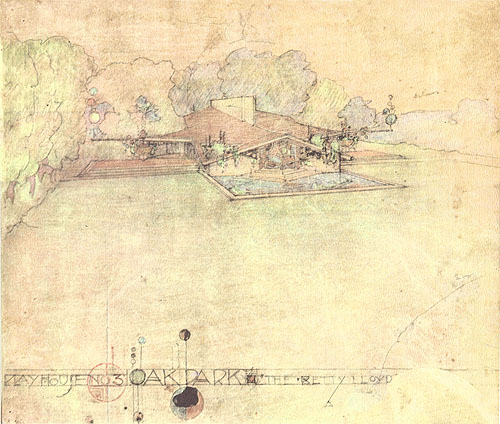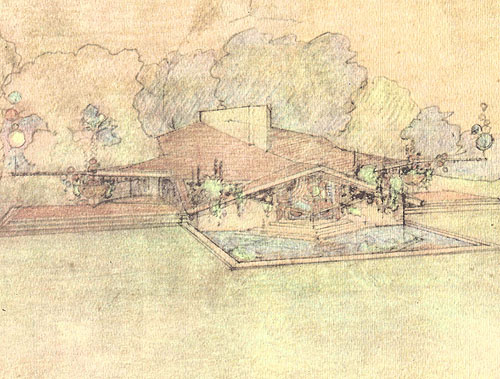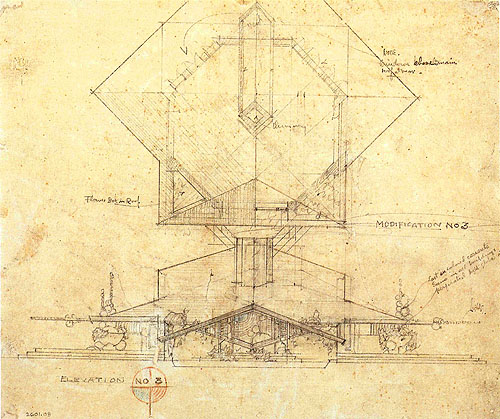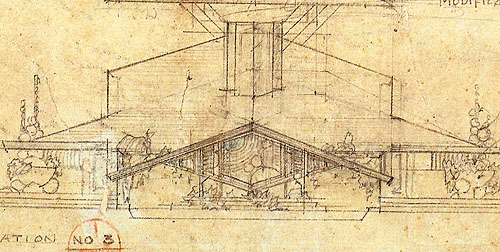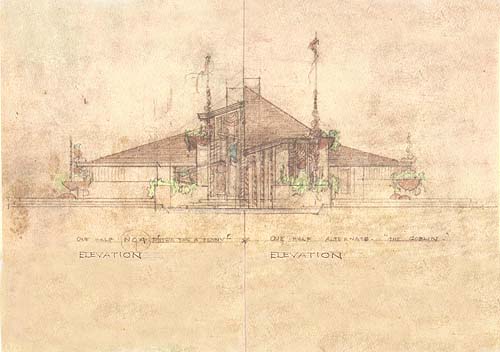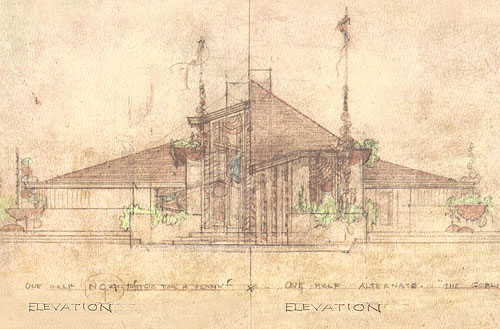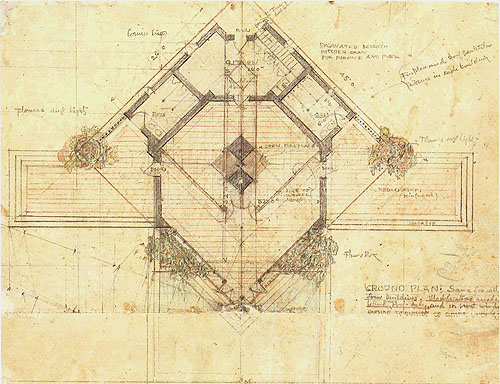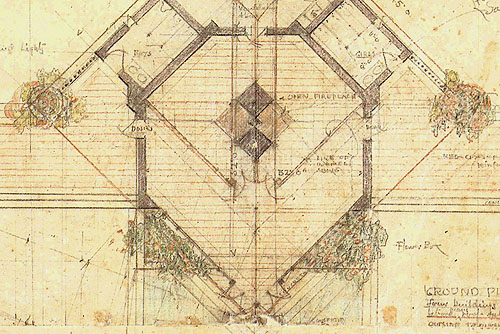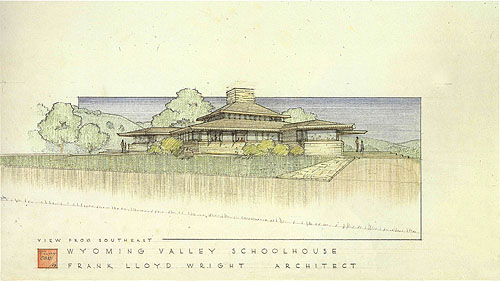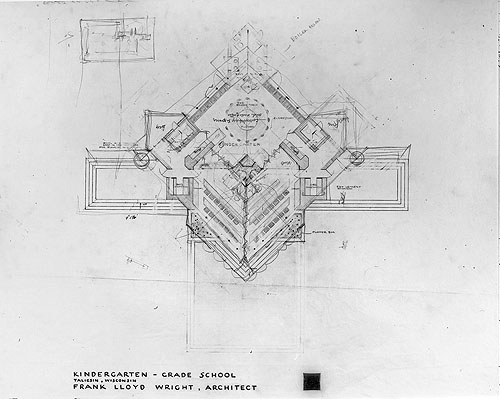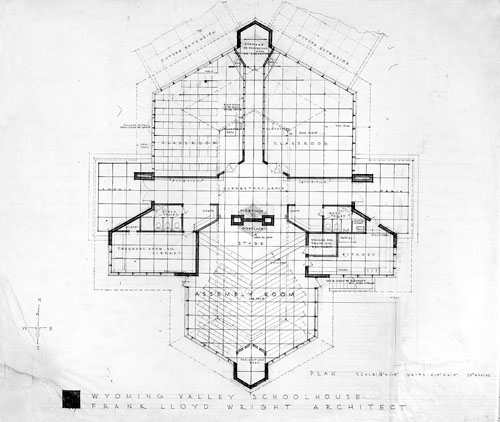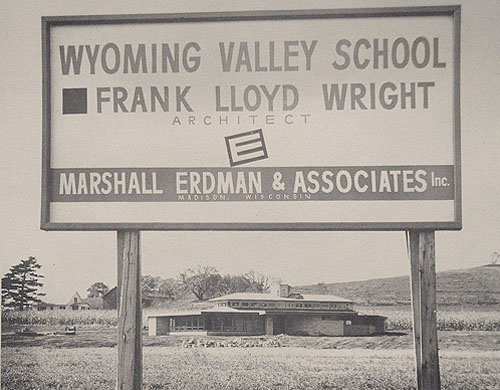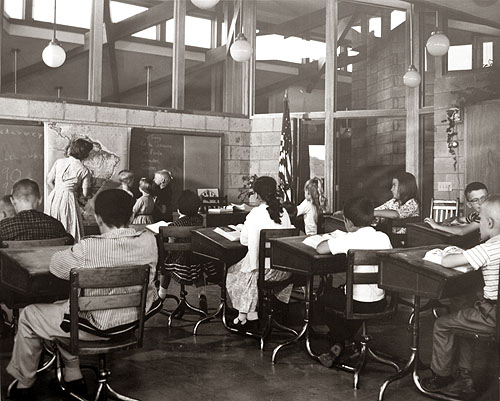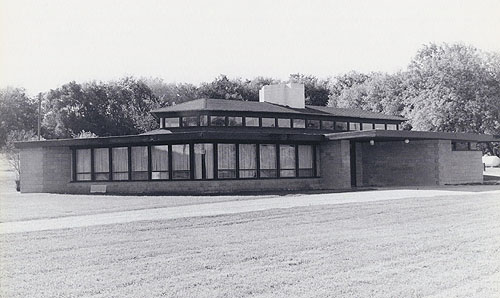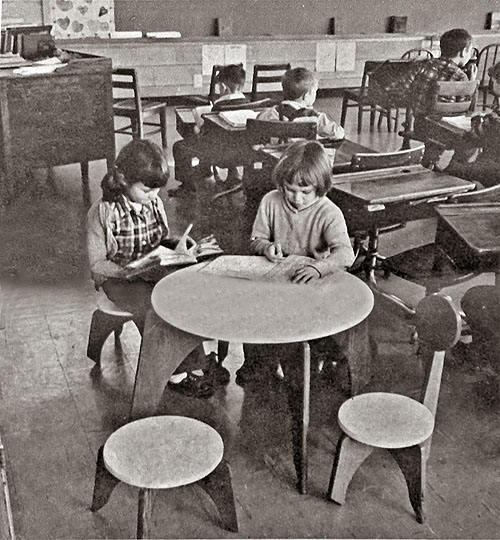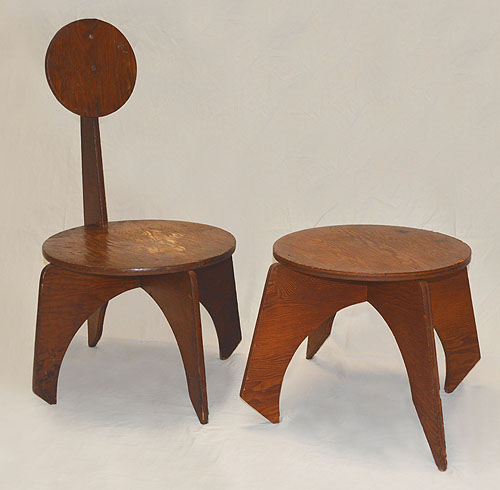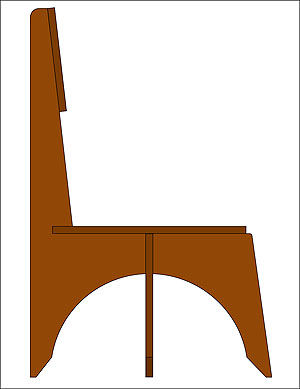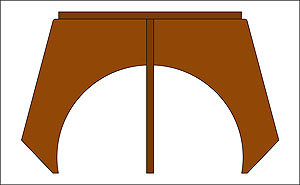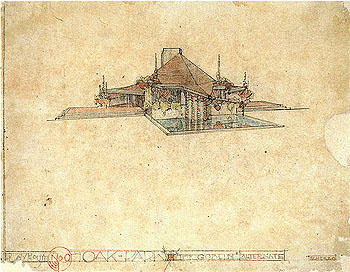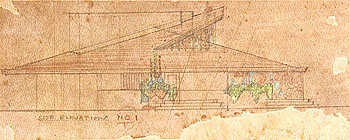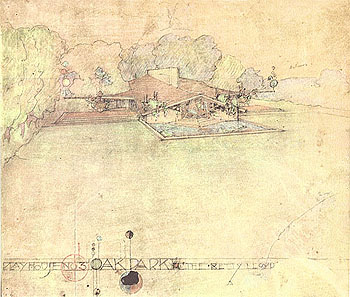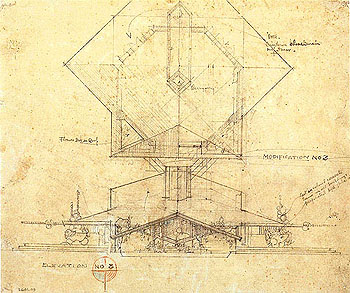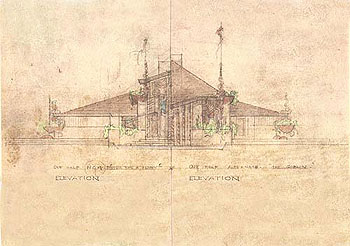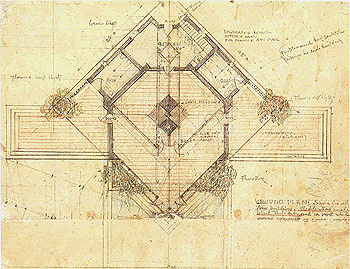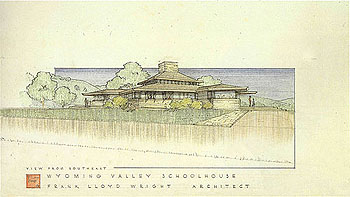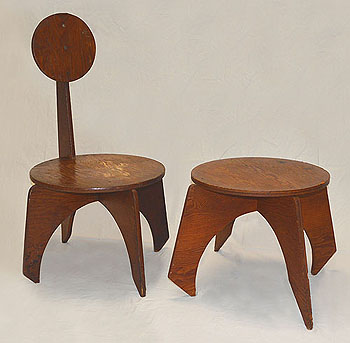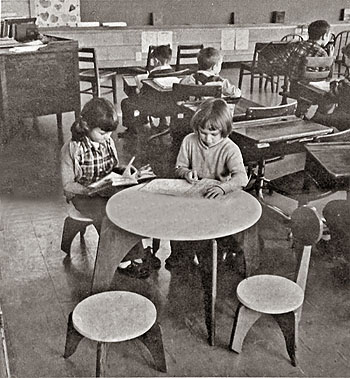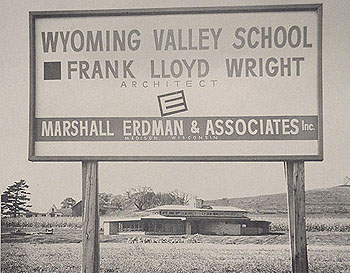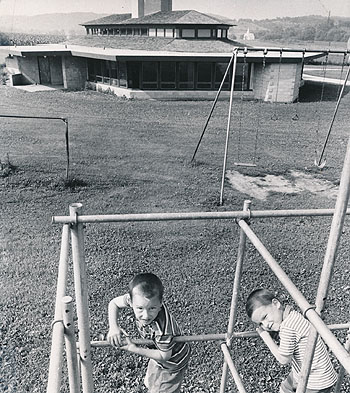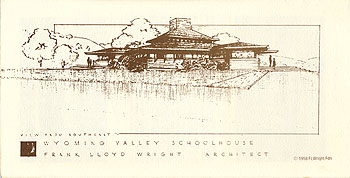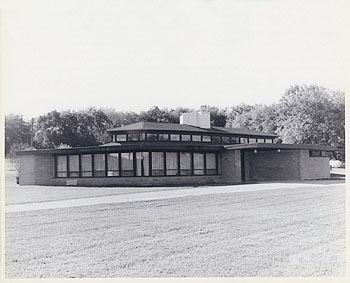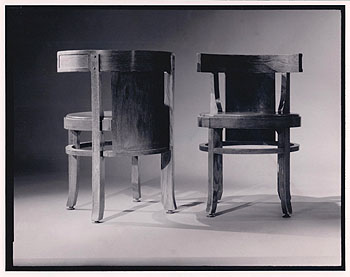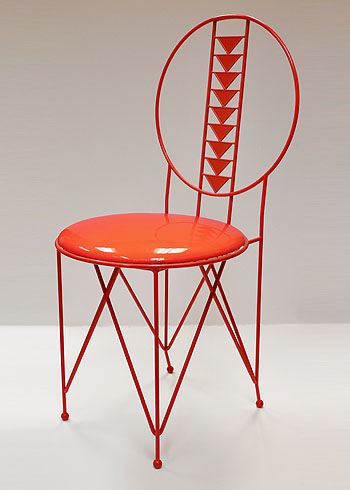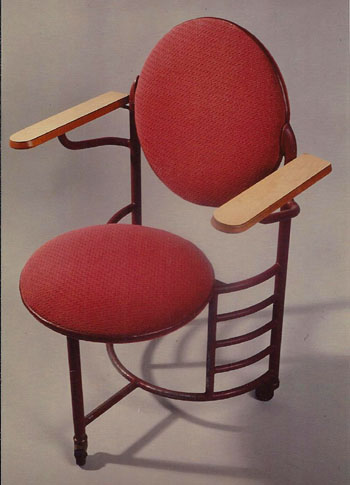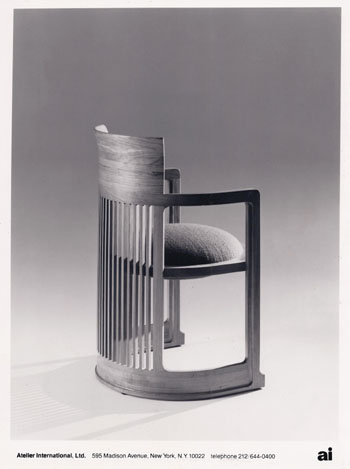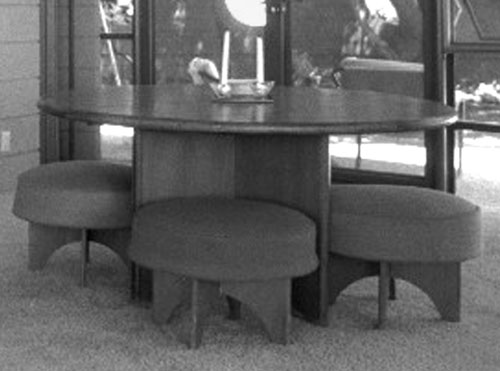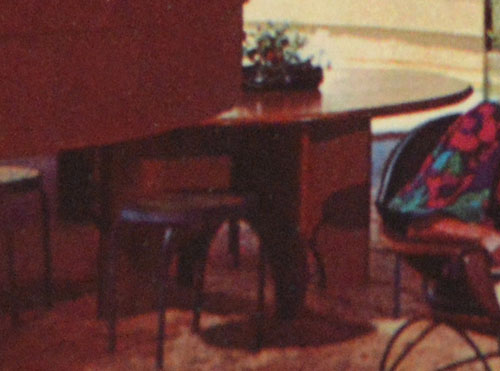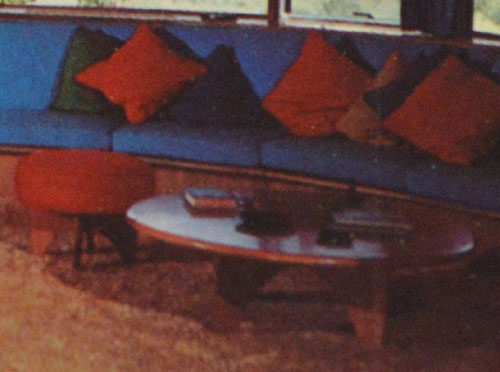
SUPPORT THE
WRIGHT LIBRARY
PROCEEDS FROM EVERY SALE GOES TO SUPPORT THE WRIGHT LIBRARY.
CLICK TO ORDER.
WE PROUDLY SUPPORT THE FRANK LLOYD WRIGHT FOUNDATION

WE PROUDLY SUPPORT THE FRANK LLOYD WRIGHT BUILDING CONSERVANCY
WE PROUDLY SUPPORT FALLINGWATER
AND THE WESTERN PENNSYLVANIA CONSERVANCY

Oak Park Play Houses "Kindersymphonies" (1926 - Project 2601)
Wyoming Valley School, Wisconsin (1956 - S.401)OAK PARK PLAY HOUSES WYOMING VALLEY SCHOOL CHAIR & STOOL OAK PARK PLAY HOUSE ITEMS WYOMING VALLEY SCHOOL
OTHER WRIGHT DESIGNED CIRCULAR CHAIRS BIBLIOGRAPHYOak Park Play Houses "Kindersymphonies"
Wyoming Valley School (1956 - S.401) is located minutes from Taliesin. Although it was designed by Frank Lloyd Wright in 1956, its roots goes back three decades. In 1926 Wright designed six Children’s playhouses for the Oak Park Playground Association. All six, variations on the same design. The basic design was square, with a fireplace in the center, and two terraces off of either side. He named the series "Kindersymphonies" (1926 - project 2601). Fanciful in design, Wright added balloons, light poles, pendants with colored globes, perforated light globes, circular lights, large circular urns. The windows appear to be elaborate stained glass geometric designs dominated by circles. Although square in design, circles decorate the design. Like the Coonley Play House and Midway Gardens, circles became decorative elements in both designs.
In 1955 when Wright published "An American Architect" p.41, he included one of the drawing of the Oak Park Playground buildings.In 1959, when Kaufmann published "Frank Lloyd Wright Drawings," he wrote, "The book would never have been undertaken without the encouragement and council of Frank Lloyd Wright..." He included four illustrations of the Play House buildings. The caption read, "Over a single symmetrical plan Wright proposed six different roof forms, each suggesting childhood’s imaginative, mysterious joys." It would appear that the whimsical designs were ever fresh in Wright’s memory.
In 1959 during Wright’s last interview he said, "A creative teacher is one of the finest examples of humanity." Then he said that a child should begin to learn what is called art at the earliest possible age. "Put blocks in the child’s hands," he said. "Let the child hold a sphere, a ball—and get a sense of the universe, a sense of God." Frank Lloyd Wright A Biography, Farr, 1961, p.278. Of the blocks, he was referring to Froebel blocks, but of the spheres, could he be reminiscing about the Oak Park Play House buildings?Wyoming Valley School, Wisconsin (1956 - S.401)
Wyoming Valley School. After the school district voted to consolidate a number of one-room school houses in January 1956, a referendum was past in April. In October, the board selected Frank Lloyd Wright to design their school. Wright immediately set out to design the school and on November 28, received a letter from the Board that "the building committee accepted the plans with enthusiasm" along with a few revision. The initial plans submitted to the Board was a resurrection of the unrealized Oak Park Kindersymphonies design, with a few modifications. Wright included some of the same design elements of the original, like the large circular vases, noting "bowl and spheres cast in red concrete for flowers and lights. One addition was a large round table surrounded by chair in the Kindergarten room, which he noted as "The Round Table."
As changes were requested, a need to enlarge the building and at the same time cut costs, many of the original "fanciful" details were deleted. Wright did specify the light fixtures, "white balls." Not only did Wright donate his fee, he donated $7,000 toward the memory of his mother, helping to lower the cost of construction and for $750 he purchased an adjoining 2 acres, bringing the site to just over five acres.Wright received a letter in January, 1957. "Dear Mr. Wright, We received the beautiful plans... This realization of this building would be a dream come true..." Once plans were approved, Herbert Fritz, one of Wright's apprentices drew up the working plans. William Storrer believed it was John Howe who finalized the plans. Ground was broken in the spring. Marshall Erdman was the general contractor.
The school was officially opened in January, 1958. Possibly harkening back to the original design, Wright sent a telegraph on January 31st, "A happy use and playtime is the little new school of Wyoming Valley. It was a pleasure to design it and I hope a lasting pleasure to learn in it..." When the town held an open house a few days later, the event drew almost 1200 visitors to a school designed to serve 67 students. On March 23, 1958, The Milwaukee Journal published an article including two photographs of "Wright's School." The second photograph, two children "Reading at a Wright designed table..."
In June, Wright published The Living City, an update to his Broadacre plan, and included a drawing of the Wyoming Valley School and a floor plan, with the caption, "Small School" and "Small School, Plan."
1) Wyoming Valley School perspective 1956. The initial plans submitted to the school board was a resurrection of the unrealized Oak Park Kindersymphonies design, with a few modifications. Courtesy of the Frank Lloyd Wright Foundation. In June, 1958, Wright published The Living City, an update to his Broadacre plan, and included a drawing of the Wyoming Valley School and a floor plan, with the caption, "Small School" and "Small School, Plan." 1B) Detail of the initial perspective submitted to the school board was a resurrection of the unrealized Oak Park Kindersymphonies design, with a few modifications. 2) Wyoming Valley School preliminary floor plan 1956. Wright included some of the same design elements of the original, like the large circular vases, noting "bowl and spheres cast in red concrete for flowers and lights. One addition was a large round table surrounded by chair in the Kindergarten room, which he noted as "The Round Table." 3) Wyoming Valley School final floor plan 1956. As changes were requested, a need to enlarge the building and at the same time cut costs, many of the original "fanciful" details were deleted. In June, 1958, Wright published The Living City, an update to his Broadacre plan, and included a drawing of the Wyoming Valley School and a floor plan, with the caption, "Small School" and "Small School, Plan." 4) Marshall Erdman was the general contractor. Ground was broken in the spring. The school was officially opened in January, 1958. "Wyoming Valley School. Frank Lloyd Wright Architect. Marshall Erdman & Associates, Inc. Madison, Wisconsin." 5) Wyoming Valley School interior. Photographed by Edward Obma, June 27, 1960. 6) Wyoming Valley School, Wyoming Valley, Wisc. Built as an elementary public school, it is located a couple miles south of Taliesin and was designed by Wright in 1956. The Wyoming School District was formed to consolidate six one-room schoolhouses in the Spring Green area. The school board members approach Mr. Wright about designing a school building to serve the students of the Spring Green area. This two room school also included an assembly room that doubled as a cafeteria. It was built to Wright’s design without any alterations. When he was told they couldn’t afford his fee, he donated his time. When he was told they couldn’t afford the building, he made a donation in his Mother’s name. It is the only elementary school built from a Wright design. December 8, 1989. Wyoming Valley School Chair & Stool
Wyoming Valley School Chair and Stool. After contacting the Avery Architectural & Fine Arts Library at Columbia University, New York City, where the Frank Lloyd Wright archives are held, we reviewed drawings and correspondence related to both projects. Specific information related to the furniture was lacking, but there were also large gaps in the correspondence. It appears that the chair and stool, as well as the table pictured, may have been a prototype. But due to the lack of funds, furniture from the existing one-room school houses was consolidated and used in the new building.
The chair and stool seem more a reflection of Wright's original design for the Oak Park Play Houses. As changes from the school board were requested, a need to enlarge the building and at the same time cut costs, many of the original "fanciful" details that tie the chair and stool to the original design were lost.
Chair: 21 3/8" wide at the base; 32 1/8" tall; 13 1/8" seat height; 16 7/8" seat diameter; 8 7/8" seat back diameter; 17 1/8" inside diameter of the legs. Stool: 23 7/8" wide at the base; 14" tall; 15 7/8" seat diameter; 16" inside diameter of the legs. Like much of Wright's furniture, it is constructed of plywood. Plywood 5/8" thick.
1) On March 23, 1958, The Milwaukee Journal published an article including two photographs of "Wright's School." The second photograph with two children included the caption; "Reading at a Wright designed table..." See additional Wright designed furniture... 2) Wyoming Valley School Chair and Stool. Chair: 21 3/8" wide at the base; 32 1/8" tall; 13 1/8" seat height; 16 7/8" seat diameter; 8 7/8" seat back diameter; 17 1/8" inside diameter of the legs. Stool: 23 7/8" wide at the base; 14" tall; 15 7/8" seat diameter; 16" inside diameter of the legs. Like much of Wright's furniture, it is constructed of plywood. Plywood 5/8" thick. See additional Wright designed furniture... 3) Wyoming Valley School Chair. Chair: 21 3/8" wide at the base; 32 1/8" tall; 13 1/8" seat height; 16 7/8" seat diameter; 8 7/8" seat back diameter; 17 1/8" inside diameter of the legs. Like much of Wright's furniture, it is constructed of plywood. Adapted and illustrated by Douglas M. Steiner. 4) Wyoming Valley School Stool. Stool: 23 7/8" wide at the base; 14" tall; 15 7/8" seat diameter; 16" inside diameter of the legs. Like much of Wright's furniture, it is constructed of plywood. Adapted and illustrated by Douglas M. Steiner.
Text copyright Douglas M. Steiner, Copyright 2017. Oak Park Play Houses "Kindersymphonies" Date: 1926
Title: Oak Park Play House No 0, Perspective, 1926 - Project 2601.
Description: In 1926 Frank Lloyd Wright designed six Children's play houses for the Oak Park Playground association. All six, variations on the same design. The basic design was square, with a fireplace in the center, and two terraces off of either side. He named the series "Kindersymphonies" (1926 - project 2601). Fanciful in design, Wright added balloons, light poles, pendants with colored globes, perforated light globes, circular lights, large circular urns. The windows appear to be elaborate stained glass geometric designs dominated by circles. Although square in design, circles decorate the design. Like the Coonley Playhouse and Midway Gardens, circles became decorative elements in both designs. In 1959 during Wright's last interview he said, "A creative teacher is one of the finest examples of humanity." Then he said that a child should begin to learn what is called art at the earliest possible age. "Put blocks in the child's hands," he said. "Let the child hold a sphere, a ball—and get a sense of the universe, a sense of God." FLW A Biography, Farr, 1961, p.278. Of the blocks, he was referring to Froebel blocks, but of the spheres, could he be reminiscing about the Oak Park Play House buildings? Although they remained unrealized for 30 years, Wright resurrected the design for the Wyoming Valley School in 1956. Photograph of original drawing. Text along bottom: Oak Park Play House ( No 0 ) "The Goblin" |Alternate| "Scherzo." Courtesy of the Frank Lloyd Wright Foundation.
Size: 10 x 7.75 Color photograph.
S#: 0172.33.0317Date: 1926
Title: Oak Park Play House No 1, Elevation, 1926 - Project 2601.
Description: In 1926 Frank Lloyd Wright designed six Children's play houses for the Oak Park Playground association. All six, variations on the same design. The basic design was square, with a fireplace in the center, and two terraces off of either side. He named the series "Kindersymphonies" (1926 - project 2601). Fanciful in design, Wright added balloons, light poles, pendants with colored globes, perforated light globes, circular lights, large circular urns. The windows appear to be elaborate stained glass geometric designs dominated by circles. Although square in design, circles decorate the design. Like the Coonley Playhouse and Midway Gardens, circles became decorative elements in both designs. In 1959 during Wright's last interview he said, "A creative teacher is one of the finest examples of humanity." Then he said that a child should begin to learn what is called art at the earliest possible age. "Put blocks in the child's hands," he said. "Let the child hold a sphere, a ball—and get a sense of the universe, a sense of God." Frank Lloyd Wright A Biography, Farr, 1961, p.278. Of the blocks, he was referring to Froebel blocks, but of the spheres, could he be reminiscing about the Oak Park Play House buildings? Although they remained unrealized for 30 years, Wright resurrected the design for the Wyoming Valley School in 1956. Photograph of original drawing. Text along bottom: Side Elevation ( No 1 ). Other drawings in the Avery Architectural & Fine Arts Library at Columbia University, New York City, where the FLW archives are held, name No 1 the "Ann Baxter. Courtesy of the Frank Lloyd Wright Foundation.
Size: 10 x 4 Color photograph.
S#: 0172.34.0317Date: 1926
Title: Oak Park Play House No 3, Perspective, 1926 - Project 2601.
Description: In 1926 Frank Lloyd Wright designed six Children's play houses for the Oak Park Playground association. All six, variations on the same design. The basic design was square, with a fireplace in the center, and two terraces off of either side. He named the series "Kindersymphonies" (1926 - project 2601). Fanciful in design, Wright added balloons, light poles, pendants with colored globes, perforated light globes, circular lights, large circular urns. The windows appear to be elaborate stained glass geometric designs dominated by circles. Although square in design, circles decorate the design. Like the Coonley Playhouse and Midway Gardens, circles became decorative elements in both designs. In 1959 during Wright's last interview he said, "A creative teacher is one of the finest examples of humanity." Then he said that a child should begin to learn what is called art at the earliest possible age. "Put blocks in the child's hands," he said. "Let the child hold a sphere, a ball—and get a sense of the universe, a sense of God." Frank Lloyd Wright A Biography, Farr, 1961, p.278. Of the blocks, he was referring to Froebel blocks, but of the spheres, could he be reminiscing about the Oak Park Play House buildings? Although they remained unrealized for 30 years, Wright resurrected the design for the Wyoming Valley School in 1956. Photograph of original drawing. Text along bottom: Play House ( No 3 ) Oak Park "The Betty Lloyd." Hand written note to right: "Balloons." Courtesy of the Frank Lloyd Wright Foundation.
Size: 9.5 x 8 Color photograph.
S#: 0172.35.0317Date: 1926
Title: Oak Park Play House No 3, Elevation and Floor Plan, 1926 - Project 2601.
Description: In 1926 Frank Lloyd Wright designed six Children's play houses for the Oak Park Playground association. All six, variations on the same design. The basic design was square, with a fireplace in the center, and two terraces off of either side. He named the series "Kindersymphonies" (1926 - project 2601). Fanciful in design, Wright added balloons, light poles, pendants with colored globes, perforated light globes, circular lights, large circular urns. The windows appear to be elaborate stained glass geometric designs dominated by circles. Although square in design, circles decorate the design. Like the Coonley Playhouse and Midway Gardens, circles became decorative elements in both designs. In 1959 during Wright's last interview he said, "A creative teacher is one of the finest examples of humanity." Then he said that a child should begin to learn what is called art at the earliest possible age. "Put blocks in the child's hands," he said. "Let the child hold a sphere, a ball—and get a sense of the universe, a sense of God." Frank Lloyd Wright A Biography, Farr, 1961, p.278. Of the blocks, he was referring to Froebel blocks, but of the spheres, could he be reminiscing about the Oak Park Play House buildings? Although they remained unrealized for 30 years, Wright resurrected the design for the Wyoming Valley School in 1956. Photograph of original drawing. Text along bottom: Elevation ( No 3 ) Hand written note to center left, "Flower Box in Roof." Top right: "Note. Windows above main roof above." Center right: "Modification No 3." Lower right: Cast in colored concrete. Same in all buildings. Perforated light globes." "Lights." Courtesy of the Frank Lloyd Wright Foundation.
Size: 9.5 x 8 Color photograph.
S#: 0172.36.0317Date: 1926
Title: Oak Park Play House No 4, Elevation (left) and No O, Elevation, 1926 - Project 2601.
Description: In 1926 Frank Lloyd Wright designed six Children's play houses for the Oak Park Playground association. All six, variations on the same design. The basic design was square, with a fireplace in the center, and two terraces off of either side. He named the series "Kindersymphonies" (1926 - project 2601). Fanciful in design, Wright added balloons, light poles, pendants with colored globes, perforated light globes, circular lights, large circular urns. The windows appear to be elaborate stained glass geometric designs dominated by circles. Although square in design, circles decorate the design. Like the Coonley Playhouse and Midway Gardens, circles became decorative elements in both designs. In 1959 during Wright's last interview he said, "A creative teacher is one of the finest examples of humanity." Then he said that a child should begin to learn what is called art at the earliest possible age. "Put blocks in the child's hands," he said. "Let the child hold a sphere, a ball—and get a sense of the universe, a sense of God." Frank Lloyd Wright A Biography, Farr, 1961, p.278. Of the blocks, he was referring to Froebel blocks, but of the spheres, could he be reminiscing about the Oak Park Play House buildings? Although they remained unrealized for 30 years, Wright resurrected the design for the Wyoming Valley School in 1956. Photograph of original drawing. Two elevations butted together. Left text: One Half No 4, "Two For a Penny." Elevation. One Half Alternate, "The Goblin." Elevation. Courtesy of the Frank Lloyd Wright Foundation.
Size: 10 x 7 Color photograph.
S#: 0172.37.0317Date: 1926
Title: Oak Park Play House Floor Plan, 1926 - Project 2601.
Description: In 1926 Frank Lloyd Wright designed six Children's play houses for the Oak Park Playground association. All six, variations on the same design. The basic design was square, with a fireplace in the center, and two terraces off of either side. He named the series "Kindersymphonies" (1926 - project 2601). Fanciful in design, Wright added balloons, light poles, pendants with colored globes, perforated light globes, circular lights, large circular urns. The windows appear to be elaborate stained glass geometric designs dominated by circles. Although square in design, circles decorate the design. Like the Coonley Playhouse and Midway Gardens, circles became decorative elements in both designs. In 1959 during Wright's last interview he said, "A creative teacher is one of the finest examples of humanity." Then he said that a child should begin to learn what is called art at the earliest possible age. "Put blocks in the child's hands," he said. "Let the child hold a sphere, a ball—and get a sense of the universe, a sense of God." Frank Lloyd Wright A Biography, Farr, 1961, p.278. Of the blocks, he was referring to Froebel blocks, but of the spheres, could he be reminiscing about the Oak Park Play House buildings? Although they remained unrealized for 30 years, Wright resurrected the design for the Wyoming Valley School in 1956. Photograph of original drawing. Text upper left: "Flowers and lights." Top right: "Excavate beneath kitchen only for furnace and fuel." "Fireplace and roof ventilation same in each building." Center right: "Flowers and lights." Lower right: "Flowers." "Ground Plan: Same for all ___ buildings. Modifications made tlineabove main roof - only, and in front windows..." Courtesy of the Frank Lloyd Wright Foundation.
Size: 10 x 7.5 Color photograph.
S#: 0172.38.0317Wyoming Valley School, Wisconsin (1956 - S.401) Date: 1956
Title: Wyoming Valley School perspective 1956 (1956 - S.401).
Description: After the school district voted to consolidate a number of one-room school houses in January 1956, a referendum was past in April. In October, the board selected Frank Lloyd Wright to design their school. Wright immediately set out to design the school and on November 28, received a letter from the Board that "the building committee accepted the plans with enthusiasm" along with a few revision. The initial plans submitted to the Board was a resurrection of the unrealized Oak Park Kindersymphonies design, with a few modifications. In June, 1958, Wright published The Living City, an update to his Broadacre plan, and included this drawing of the Wyoming Valley School and a floor plan, with the caption, "Small School" and "Small School, Plan." Courtesy of the Frank Lloyd Wright Foundation.
Size: 10 x 5 color photograph.
S#: 1147.76.0317Date: 1958/1926
Title: Wyoming Valley School Chair & Stool (1956 - S.401) (Oak Park Play House)
Description: After contacting the Avery Architectural & Fine Arts Library at Columbia University, New York City, where the Frank Lloyd Wright archives are held, we reviewed drawings and correspondence related to both projects. Specific information related to the furniture was lacking, but there were also large gaps in the correspondence. It appears that the chair and stool, as well as the table pictured, may have been a prototype. But due to the lack of funds, the existing furniture from the existing one-room school houses was consolidated and used in the new building. See additional Wright designed furniture...
Size: Chair: 21 3/8" wide at the base; 32 1/8" tall; 13 1/8" seat height; 16 7/8" seat diameter; 8 7/8" seat back diameter; 17 1/8" inside diameter of the legs. Stool: 23 7/8" wide at the base; 14" tall; 15 7/8" seat diameter; 16" inside diameter of the legs. Like much of Wright's furniture, it is constructed of plywood. Plywood 5/8" thick.
S#: 1259.50.0117Date: 1958
Title: Wyoming Valley Grammar School, Wyoming Valley, Wisc. Stool and Chair 1958 (1956 - S.401).
Description: Diane Lockman and Shari Ripley are reading at a Wright designed table and chairs. Built as an elementary public school, it is located a couple miles south of Taliesin and was designed by Wright in 1956. The Wyoming School District was formed to consolidate six one-room schoolhouses in the Spring Green area. The school board members approach Mr. Wright about designing a school building to serve the students of the Spring Green area. This two room school also included an assembly room that doubled as a cafeteria. It was built to Wright’s design without any alterations. When he was told they couldn’t afford his fee, he donated his time. When he was told they couldn’t afford the building, he made a donation in his Mother’s name. It is the only elementary school built from a Wright design. Published in The Milwaukee Journal, March 23, 1958. Caption: "Reading at a Wright designed table are Diane Lockman (left), and Shari Ripley, Spring Green." See additional Wright designed furniture...
Size: 8 x 8.75 B&W Photograph.
S#: 1259.65.0120Date: 1958
Title: Wyoming Valley School Sign 1958 (1956 - S.401) Wyoming Valley, Wisc.
Description: After the school district voted to consolidate a number of one-room school houses in January 1956, a referendum was past in April. In October, the board selected Frank Lloyd Wright to design their school. Wright immediately set out to design the school and on November 28, received a letter from the Board that "the building committee accepted the plans with enthusiasm" along with a few revision. The first plans submitted to the Board was a resurrection of the unrealized Oak Park Kindersymphonies design, with a few modifications. Wright included some of the same design elements of the original, like the large circular vases, noting "bowl and spheres cast in red concrete for flowers and lights. One addition was a large round table surrounded by chair in the Kindergarten room, which he noted as "The Round Table." As changes were requested, a need to enlarge the building and at the same time cut costs, many of the original "fanciful" details were deleted. Wright did specify the light fixtures, "white balls." Not only did Wright donate his fee, he donated $7,000 toward the memory of his mother, helping to lower the cost of construction and for $750 he purchased an adjoining 2 acres, bringing the site to just over five acres. Wright received a letter in January, 1957. "Dear Mr. Wright, We received the beautiful plans... This realization of this building would be a dream come true..." Once plans were approved, Herbert Fritz, one of Wright’s apprentices drew up the working plans. William Storrer believed it was John Howe who finalized the plans. Ground was broken in the spring. Marshall Erdman was the general contractor. Sign reads: "Wyoming Valley School. Frank Lloyd Wright Architect. Marshall Erdman & Associates, Inc. Madison, Wisconsin."
Size: Copy 10 x 8 photograph of image pushed in the newspaper.
S#: 1259.51.0317Date: 1967
Title: Wyoming Valley Grammar School, Wyoming Valley, Wisc. 1967 (1956 - S.401).
Description: View of the Wyoming Valley Grammar School from the South. Designed by Frank Lloyd Wright in 1956. The Wyoming School District was formed to consolidate six one-room schoolhouses in the Spring Green area. The school board members approach Mr. Wright about designing a school building to serve the students of the Spring Green area. This two room school also included an assembly room that doubled as a cafeteria. It was built to Wright’s design without any alterations. When he was told they couldn’t afford his fee, he donated his time. When he was told they couldn’t afford the building, he made a donation in his Mother’s name. It is the only elementary school built from a Wright design. Clipping taped to verso: "...plans, among them the long delayed auditorium for Madison. Concerts are held in the theater. Wright designed and helped pay for the Wyoming Valley grade school near Dodgeville in 1957 because, he said, he wanted to do something for the county." Stamped on clipping" Su Dec 10, 1967." Acquired from the archives of The Milwaukee Journal. Original 5.25 x 5.75 B&W Photograph.
Size: Original 5.25 x 5.75 B&W Photograph.
S#: 1720.81.1021Date: 1989
Title: Wyoming Valley Schoolhouse For Sale 1989 (1956 - S.401).
Description: Brochure for the sale if the Wyoming Valley Schoolhouse, by the River Valley School District. (Produced by the River Valley School District, Spring Green, Wisconsin.) Announcing the sale of a Frank Lloyd Wright Building. "Wyoming Valley Schoolhouse. Frank Lloyd Wright Architect. The Wyoming Valley School, six miles south of Spring Green, Wisconsin, now owned by the River Valley School District, will be ordered for sale at public auction on November 16, 1989. The building was designed in 1926, as explained by the Director of the Frank Lloyd Wright archives: "This small country school house, built near Taliesin in Wisconsin, is a modification both in plan and elevation of the little "Kindersymphonies" that were designed as children's playhouses for the Oak Park Playground Association in 1926. The scale of the plan and therefore elevation as well have been enlarged to take care of the needs of the school: two large classrooms on one side of the plan, and assembly room on the other..." Includes seven photographs and illustrations. One copy. Acquired from the estate of Cary Caraway. Included in a lot related to Cary Caraway. Pp 6.
Size: Sheet 11 x 17, folded to 11 x 5.75
ST#: 1989.119.1121Date: 1989 Title: Wyoming Valley Grammar School (1956 - S.401) Wyoming Valley, Wisc.
Description: Built as an elementary public school, it is located a couple miles south of Taliesin and was designed by Wright in 1956. The Wyoming School District was formed to consolidate six one-room schoolhouses in the Spring Green area. The school board members approach Mr. Wright about designing a school building to serve the students of the Spring Green area. This two room school also included an assembly room that doubled as a cafeteria. It was built to Wright’s design without any alterations. When he was told they couldn’t afford his fee, he donated his time. When he was told they couldn’t afford the building, he made a donation in his Mother’s name. It is the only elementary school built from a Wright design. Stamped on verso: "Dec 8 89". Acquired from the archives of the Chicago Tribune.
Size: Original 10 x 8 B&W Photograph.
ST#: 1989.80.0212
Other Wright Designed Circular Chairs Date: Designed 1905 Title: Barrel Chairs 1905. Frank L. Smith Bank Chairs, Dwight, IL (1905 - S.111).
Description: Two barrel chairs designed by Frank Lloyd Wright for the Frank L. Smith Bank in 1905. The chairs were manufactured by the John W. Ayers, Co., Chicago. Caption pasted on verso: "Frank Lloyd Wright designed barrel chair, from 1906." Stamped on caption "Jan 15 ‘89". Second caption pasted on verso: "Barrel Chairs designed by Frank Lloyd Wright for a Dwight, Ill., bank in 1906 ($18,000 each), at Struve Gallery, 309 W. Superior St." Stamped on caption "Sep 17 ‘89". Stamped on verso: "Jan 18, 1989". Photographed by Struve Gallery. Acquired from the archived of the Chicago Tribune. See other examples of Wright designed furniture for the Frank L. Smith Bank. For more information see out Wright Study.
Size: Original 10 x 8 B&W Print.
ST#: 1989.74.0811
Date: Designed 1914
Title: Midway Gardens Side Chairs 1986 (1913 - S.180).
Description: Midway Gardens was designed by Frank Lloyd Wright in 1913, built in 1914 and demolished in 1929. This Midway Garden chair was designed by Wright in 1914, but never produced. In 1986, Cassina produced a line of furniture designed by Frank Lloyd Wright. Cassina 603 Midway 2. "The Characteristic of this chair is the lightness of the steel rod structural framework. It is part of a set that includes tables built along similar lines." Cassina Catalog, 1985, p.16-17. "Chairs in glossy enamelled steel rod, white, red, blue, or grey. Removable seat and back padded with polyurethane foam. This model is also available without padded back. Fabric upholstery." P.40-41. Matching tables sold with square or round crystal glass tops. The base is in glossy enamelled steel rod and available in white, red, blue or grey. Printed on base, "Cassina ©. A Design by Frank Lloyd Wright. Certified by The Frank Lloyd Wright Foundation." Stamped in frame: "1017" and "1053." Steel frame is in red enamel, seat in red vinyl. Two chairs.
Size: 34.65" High x 15.75 Wide x 18.12" Deep. Seat is 18.31" High.
ST#: 1986.72.1016 1986.73.1016
See additional information.Date: 1958/1926
Title: Wyoming Valley School Chair & Stool (1956 - S.401) (Oak Park Play House)
Description: After contacting the Avery Architectural & Fine Arts Library at Columbia University, New York City, where the Frank Lloyd Wright archives are held, we reviewed drawings and correspondence related to both projects. Specific information related to the furniture was lacking, but there were also large gaps in the correspondence. It appears that the chair and stool, as well as the table pictured, may have been a prototype. But due to the lack of funds, the existing furniture from the existing one-room school houses was consolidated and used in the new building. See additional Wright designed furniture...
Size: Chair: 21 3/8" wide at the base; 32 1/8" tall; 13 1/8" seat height; 16 7/8" seat diameter; 8 7/8" seat back diameter; 17 1/8" inside diameter of the legs. Stool: 23 7/8" wide at the base; 14" tall; 15 7/8" seat diameter; 16" inside diameter of the legs. Like much of Wright's furniture, it is constructed of plywood. Plywood 5/8" thick.
S#: 1259.50.0117Date: Designed 1936 Title: Armchair 1936. S.C. Johnson & Son Administration Building Arm Chair (1936 - S.237) 1981.
Description: Three legged arm chair with wheels, designed by Frank Lloyd Wright in 1936, three-quarter view facing left. Red painted aluminum, upholstered seat and back, wood arms are laminated. 37.5 (H) x __ (W) x 21.125 (D). Photographed by Quiriconi-Tropea Photographers. Acquired from Kelmscott Galleries.
Size: 3.5 x 5 color photograph.
ST#: 1981.82.0413
Date: Designed in 1937 for the Herbert F. Johnson Residence Title: Barrel Chair 1986.
Author: Atelier International, Ltd.
Description: Text on face: "Atelier International, Ltd. 595 Madison Avenue, N.Y. 10022."Label on verso: "Barrel Chair. Designed in : 1937. Frank Lloyd Wright." Stamped on verso: Dec 9, 1986." Wright first designed the Barrel chair for the Darwin Martin Residence. (S.100 - 1904), "Frank Lloyd Wright’s Martin House", Quinan, 2004, pages 136,166-7, 181. Slight modifications were made to the design for the Herbert F. Johnson Residence, Wingspread (S.239 - 1937). This chair is manufactured after the Wingspread variation. (Corresponds to the Frank Lloyd Wright, The Cassina/ai Masters Program)
Size: Original 7.5 x 10 B&W photograph.
ST#: 1986.44.0711
Date: 1958/1926
Title: Wyoming Valley School Chair & Stool (1956 - S.401) (Oak Park Play House - 1926)
Description: After contacting the Avery Architectural & Fine Arts Library at Columbia University, New York City, where the Frank Lloyd Wright archives are held, we reviewed drawings and correspondence related to both projects. Specific information related to the furniture was lacking, but there were also large gaps in the correspondence. It appears that the chair and stool, as well as the table pictured, may have been a prototype. But due to the lack of funds, the existing furniture from the existing one-room school houses was consolidated and used in the new building. See additional Wright designed furniture...
Size: Chair: 21 3/8" wide at the base; 32 1/8" tall; 13 1/8" seat height; 16 7/8" seat diameter; 8 7/8" seat back diameter; 17 1/8" inside diameter of the legs. Stool: 23 7/8" wide at the base; 14" tall; 15 7/8" seat diameter; 16" inside diameter of the legs. Like much of Wright's furniture, it is constructed of plywood. Plywood 5/8" thick.
S#: 1259.50.0117Date: Designed 1959 Title: Aime and Norman Lykes Residence Living Room, Circa 1968 (1959 - S.433).
Description: Detail of the Lykes Residence Dining Room table and chairs. According to John Rattenbury, a few days before his death, Wright sketched out the plans for the home, set them aside, but never was able to returned to them, due to his death. Rattenbury completed the working drawings and specifications in 1966. Construction took place on the home for the next two years. Rattenbury designed the furniture and built-ins, adapted from the original plans created by Wright before his death. Photographed by William Storrer, circa 1968. Courtesy of the Oak Park Public Library.
Date: Designed 1959 Title: Aime and Norman Lykes Residence Living Room, 1970 (1959 - S.433).
Description: Detail of the round Lykes Residence Dining Room table. Lykes Residence Living Room viewed from the study. The fireplace is on the far left. The exit to the Garden Court is on the left behind Aime Lykes. Built-in seating under the windows are on the right. John Rattenbury worked with Wright on the initial plans for the home. According to Rattenbury, a few days before his death, Wright sketched out the plans for the home, set them aside, but never was able to returned to them, due to his death. Rattenbury completed the working drawings and specifications in 1966. He designed the furniture and built-ins, adapted from the original plans created by Wright before his death. The round Dining Room table is on the left. A small round end table is in the center. A hassock and coffee table is on the right. Photographed by Neil Koppes.
Date: Designed 1959 Title: Aime and Norman Lykes Residence Living Room, 1970 (1959 - S.433).
Description: Detail of the Lykes Residence hassock and coffee table. Lykes Residence Living Room viewed from the study. The fireplace is on the far left. The exit to the Garden Court is on the left behind Aime Lykes. Built-in seating under the windows are on the right. John Rattenbury worked with Wright on the initial plans for the home. According to Rattenbury, a few days before his death, Wright sketched out the plans for the home, set them aside, but never was able to returned to them, due to his death. Rattenbury completed the working drawings and specifications in 1966. He designed the furniture and built-ins, adapted from the original plans created by Wright before his death. The round Dining Room table is on the left. A small round end table is in the center. A hassock and coffee table is on the right. Photographed by Neil Koppes.
SEE OTHER WRIGHT DESIGNED CHAIRS Bibliography
"An American Architect," Wright, 1955, p.41. "The Milwaukee Journal," March 23, 1958 "The Living City," Wright, 1958, p.128-130. "Frank Lloyd Wright Drawings," Kaufmann, 1959, "Frank Lloyd Wright A Biography," Farr, 1961, p.278. "Frank Lloyd Wright Drawings. Masterworks from the Frank Lloyd Wright Archives," Pfeiffer, 1990, p.216, 233. "Frank Lloyd Wright Monograph 1924-1936," Pfeiffer, 1990, p.34. "Frank Lloyd Wright Monograph 1951-1959," Pfeiffer, 1990, p. "Frank Lloyd Wright Companion," Storrer, 1993, p.432. "Frank Lloyd Wright, The Heroic Years: 1920 - 1932," Pfeiffer, 2009, p.150. "Frank Lloyd Wright, Complete Works 1943-1959," Pfeiffer; Gossel, 2009, p.480. "Frank Lloyd Wright, Complete Works 1917-1942," Pfeiffer; Gossel, 2010, p.159. "National Register of Historic Places," Heggland, 2016
Additional Wright Studies SEE ADDITIONAL WRIGHT STUDIES Frank Lloyd Wright's First Published Article (1898) Photographic Chronology of Frank Lloyd Wright Portraits
"Frank Lloyd Wright's Nakoma Clubhouse & Sculptures." A comprehensive study of Wright’s Nakoma Clubhouse and the Nakoma and Nakomis Sculptures. Now Available. Limited Edition. More information.
HOME ARTIFACTS AUDIO BOOKS PERIODICALS PHOTOS POSTCARDS POSTERS STAMPS STUDIES ASSISTING ABOUT SLIDE SHOW To donate or pass on information, comments or questions:
steinerag@msn.com
©Copyright Douglas M. Steiner, 2001, 2025
